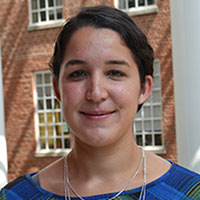Timeline to eliminate cervical cancer varies widely based on wealth
September 29, 2021

Dr. Jenny Spencer
Increasing rates of vaccination against human papillomavirus (HPV) will lead to a near-elimination of cervical cancer in some communities by 2030, according to recent research published in Cancer Epidemiology, Biomarkers & Prevention. However, these projections point to a stark truth: a 14-year delay in areas with higher rates of poverty.
More than 90 percent of cervical cancers can be traced to HPV infection, and approximately 14,000 people are diagnosed with cervical cancer per year in the United States alone — which leads to roughly 4,000 deaths annually.
“I’ve always been very interested in HPV vaccination because I think there’s so much promise there to prevent cancer,” said Jennifer Spencer, PhD, lead author of the study and alumna of the UNC Gillings School of Global Public Health. “Unfortunately in the U.S., we’re still failing to realize that promise in a lot of ways. The fact that some places will hit this goal a decade before other places is a little bit of a gut punch.”
Effective vaccines for HPV, a virus that is transmitted sexually, are recommended for all adolescents and have been widely available since 2006. The World Health Organization places the threshold for near-elimination of cervical cancer at fewer than four cases per 100,000 people, and researchers anticipate communities with low poverty rates will reach this threshold by 2030. However, communities with high poverty rates face a very different reality, and the same research places the date for near-elimination in 2044 in these communities.
According to Spencer, this disparity is not linked to rates of vaccination, which are approximately 70 percent across both areas. It is likely related, at least in part, to differences in the rates of cervical cancer screening in high- and low-poverty counties.
“Vaccination can do a lot of good, but it’s unlikely that the disparities can be addressed through just vaccination,” she said. “The next step is to identify what policies we can use to close these gaps in the future.”
Estimating the benefits of HPV vaccination is necessary because the first cohorts of people to be vaccinated as adolescents are approaching the age of 30, and cervical cancer is most often diagnosed in people over that age. Predictive models can help pick up disparities earlier, allowing more time to design programs to address them.
The research team drew on existing models of the spread of HPV to create two versions of its model for hypothetical counties, one in the highest and the other in the lowest poverty quartile, drawing on data from the National Immunization Survey-Teen, National Health Interview Survey, and National Health and Nutrition Examination Survey.
The models were tested for validity against existing data, then used to simulate cervical cancer rates through 2070. They predicted that the threshold for near-elimination of cervical cancer will be reached by 2030 in low-poverty areas and 2044 in high-poverty areas.
Having worked with Noel T. Brewer, PhD, Gillings Distinguished Professor in Public Health, on projects around HPV vaccination and with Stephanie B. Wheeler, PhD, on geographic disparities in outcomes, Spencer — who earned a Doctor of Public Health degree in health policy and management from the Gillings School in 2019 — notes that the idea to combine these two approaches to explore geographic disparities in HPV vaccination and cervical cancer outcomes was a natural next step. In fact, this research built on her dissertation work at UNC.
“This research was, in a lot of ways, a culmination of what I learned at UNC Gillings,” she said. “We focused on using these methods to understand the impact of policies on health equity and identify ways to improve it.”
This study was funded by the University of North Carolina’s Cancer Care Quality Training Program and the Dana-Farber/Harvard Cancer Center Training in Oncology Population Sciences Program.
Study co-authors include Gillings School alumna Tamera Coyne-Beasley, PhD — who earned a Master of Public Health in epidemiology from the School in 1997 — and faculty members Brewer; Justin Trogdon, PhD; Morris Weinberger, PhD, Vergil N. Slee Distinguished Professor of Healthcare Quality Management; and Wheeler.
Contact the UNC Gillings School of Global Public Health at sphcomm@unc.edu.
